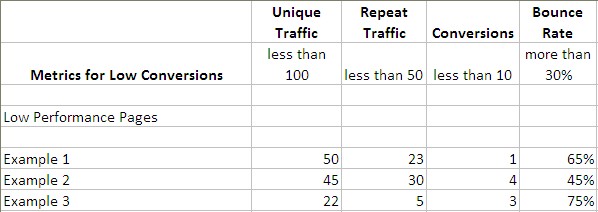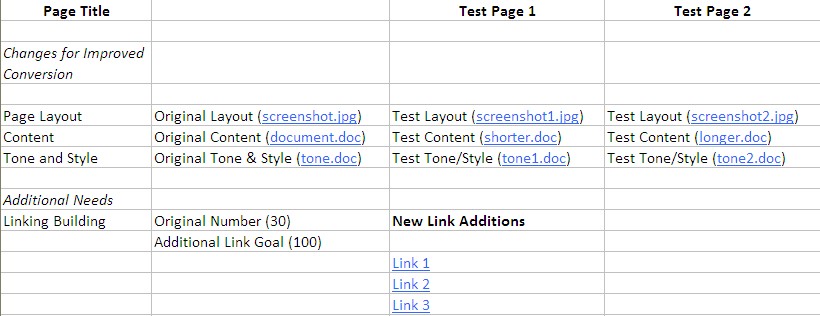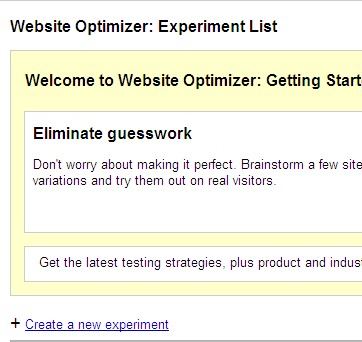You’ve done your SEO; you’re keeping an eye on your site analytics, networking, writing content – all the things a good webmaster does to show his or her site tender loving care. These methods seem to be working because you’re getting great traffic and a good number of conversions. Why question success when it looks like your efforts to improve SEO are paying off?
You don’t really need to know why visitors are coming, just as long as there are visitors and conversions, right? It must be X, Y, Z, because you’ve done X, Y, Z, so let’s leave well enough alone, shall we?
No, let’s not, and here’s why: there’s always room for improvement.
Imagine you have a 20% conversion rate and are getting 3,000 visitors a month. What if you could improve your SEO to raise your conversion rate to 30% and attract an additional 1,000 visitors each month? How much better would you be doing? How much more “successful” would your website be? Are you interested in finding out?
Many SEOs are perfectionists. We use the three Ts, always seeking to improve SEO, always seeking to create a tighter, stronger, traffic-bringing, converting website – and you should too.
Warning: This is a rather long article, but contains a great amount of information. We dithered over whether to break it into two parts; it seemed more convenient for our readers to have all the information on one page. If you don’t have time to read it, do bookmark it and come back later.
The Three Ts for Improved SEO
Improved site optimization is outlined by the three Ts: Tweaking, Testing, and Tracking, in that order. Using this formula can slowly but surely increase your traffic and conversions. You can download our SEO Improvements Sample Sheet used for this article.
SEO Improvement Involves Continuous SEO Tweaking
Before you change anything, you have to know what to change. You don’t just go in and willy-nilly move things around. The best place to start in on any low performance pages. First, however, you have to qualify and quantify what you’re going to use as the metrics, or the definition, of a low conversion page. 100 unique visitors or less? 3 conversions or less? A bounce rate of over 30%?
Once you choose your metrics, dig into your analytics program and create a list of pages that match the metric for low conversions. It’s helpful if you lay it out in a spreadsheet, like this

Compare the first on list of low performance pages with a similar high performance page. Compare:
- Meta date: Title and description
- Page layout: How does the low performance page (LPP) look compared to the high performance page (HPP)?
- Information value: Does the LPP have more valuable information than the HPP?
- Content: Does the LPP have shorter content? Longer content? Is the HPP more clearly laid out?
- Tone and style: Does the HPP speak more to the visitor than the other? Have you addressed needs in the high performance page, yet not in the low performance page?
- Links: Is it simply that the HPP has more links pointing to it than the LPP? Is it getting more traffic because it has better exposure?
- Ranking: Does the HPP rank higher in the SERPs (Search Engine Results Pages) for its keyword than the LPP?
- Competition: Does the LPP have more competition for its key term than the HPP does?
Once you’ve defined the differences, it’s time to begin tweaking your chosen low performance page. Again, you don’t simply go in and change things, however. You move to the next T.
SEO Testing
It’s important that you don’t remove your current page and replace it with a brand new rebuild. Even though you’ve compared your LPP with a similar HPP, you still have to find out if the differences are the problem – or which difference is the problem. Google Website Optimizer is a great program for this. GWO allows you to create a test page, while keeping the original up, so you can compare how the variant (testing page) performs against the original.
Go back to your spreadsheet and mark the possible changes for the LPP, using the information you gained by comparing the low and high performance pages. The great thing about MS Excel (other spreadsheets may allow the same), is that you can link to other files on your computer from within the spreadsheet for easy reference.

When using GWO, it’s best to start with one change rather than many. Choose which change you’ll start with, and create a website page similar to your LPP; the only difference should be the change you’ve chosen to implement. Make sure you add <meta name=”robots” content=”noindex” /> in the header, because you don’t want the search engines to index your test page. Once your page is created with the appropriate robots tag, publish it.
Sign into GWO and start a new experiment.

Now, the steps are pretty clearly laid out, but don’t hesitate to ask a coding friend, talk to your webmaster (if you have one) or hire a web coder. If you hire someone to help set up the code, it shouldn’t take more than 10 – 20 minutes per test, and they need to know the difference between the <head> tag and the footer. To get the best bang for your buck, have several tests ready. Most coding, including ours, is charged by the hour.
Once the experiment is setup, start it. GWO will then start delivering your variant (testing page) to visitors at a steady rate. Depending on how much traffic your page gets, you can find out whether your change makes a difference within a month.
While you’re waiting for the data to gather don’t just sit back and wait. You have other low performance pages to work on. You may have other changes you can make that won’t affect the testing pages, such as link building. As well, you can create any number of experiments with GWO.
Eventually, whether it takes a month or three months, your first experiment will finish. A finished experiment will have a declared winner: which version brought the best conversions. If you have more than one testing page, remove the losing pages from your website, keeping the winner. The winner becomes your new “original page”.
Start a new experiment based on the next needed change. For instance, if your first experiment was based on the page layout, the next experiment might be based on the content.
Improving SEO Involves Continuous SEO Tracking and Tweaking
While the experiments are going on, your analytics program will still be keeping track of your chosen metrics. You should be, as well. Again, go back to your spreadsheet.

Once the first experiment is finished for a low performance page, keep track of the results by putting in your metric statistics at the end of each month. Each time you finish an experiment, make the declared winner your new “original page” and track the results for at least three months.
Rinse and repeat.
Continue with the three Ts until your page falls out of the Low Performance Page category. Move on to the next page (s).
In Conclusion
The three Ts of improved SEO are vital to a continually growing, high conversion website. By tweaking, testing and tracking, almost any page can become a powerful tool for the success of your online business. If you’d like to know more about testing your SEO and website pages or need to hire a professional SEO company to provide these services for you, please contact Level343.




































10 Responses
Congrats for having such a popular blog.
Thanks Alex, glad you’re enjoying it 🙂
What do you think about SEO after Panda?
Not sure what you mean by your question? Organic SEO has not changed. We still write content that has value, we don’t stuff or use content farms. Maybe other SEO’s are feeling the Panda epidemic but the SEO’s we know and work with are smiling all the way to the bank.
Nice article Gabriella! i really got a sound idea about what i should do. thanks a lot!
I think SEO is very important thing for a website. but for doing it better you need to know that how it will be better ?
For betterment you have to generate unique traffic on your website..
yes i agree with your points like ..Tweaking, Testing, and Tracking,
because using the formula would be slowly but surely increase your traffic and conversions.
Hi Jahnelle,
Excellent Article! Thank you.
Great article Gabriella. As a Copywriter I’m on the SEO sidelines somewhat, but I always find it surprising when people appear to simply accept what they have.
The assumption that you can forever tread water, with rankings and traffic never getting better, or worse, is so misguided it’s untrue. Whilst you probably can do too much tweaking, there’s certainly no harm in testing elements of a page.
Content is one place that you need to keep fresh – in my opinion at least. If you keep going back to a site, you don’t necessarily want to read exactly the same thing each time. The same is probably true of search engine crawlers too.
A very clear and common sense guide to effective ongoing optimisation, many thanks.
This is just so refreshing to read! Especially after arguing with a marketing manager who refuses to budge on the thought process that “faster sales = better” regardless of how much testing presented evidence that shows more leads AND conversions through other methods.
The trick is getting the marketing manager to listen ;). Good luck Rebekah & thanks for stopping by